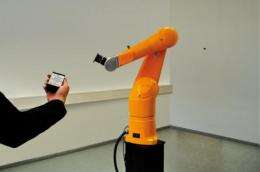Controlling robotic arms is child's play

Move your arm and the robot imitates your movement. This type of intuitive handling is now possible thanks to a new input device that will simplify the control of industrial robots in the future. But that is not all: The sensor system can also help regulate the movements of active prostheses. The new technology will be presented at the Sensor+Test trade fair from June 7-9 in Nuremberg.
Catching a ball is no problem for most people. Getting a robotic arm to catch a ball using a catcher attachment is a bit trickier. To find out just how tricky it is – or to see if it's easier than they think – visitors to the Sensor+Test trade fair in Nuremberg should head for the Fraunhofer booth, Booth 202 in Hall 12. There, researchers will be presenting an industrial robotic arm with six joints, at the end of which is a catcher. Visitors can control the arm using a hand-held input device: When they move the hand holding the device, the robot emulates their movement. "The input device contains various movement sensors, also called inertial sensors," says Bernhard Kleiner of the Fraunhofer Institute for Manufacturing Engineering and Automation IPA in Stuttgart, who leads the project. The individual micro-electromechanical systems themselves are not expensive. What the scientists have spent time developing is how these sensors interact. "We have developed special algorithms that fuse the data of individual sensors and identify a pattern of movement. That means we can detect movements in free space," summarizes Kleiner.
What may at first appear to be a trade show gimmick, is in fact a technology that offers numerous advantages in industrial production and logistical processes. The system could be used to simplify the programming of industrial robots, for example. To date, this has been done with the aid of laser tracking systems: An employee demonstrates the desired motion with a hand-held baton that features a white marker point. The system records this motion by analyzing the light reflected from a laser beam aimed at the marker. Configuring and calibrating the system takes a lot of time. The new input device should eliminate the need for these steps in the future – instead, employees need only pick up the device and show the robot what it is supposed to do.
The system has numerous applications in medicine, as well. Take, for example, gait analysis. Until now, cameras have made precise recordings of patients as they walk back and forth along a specified path. The films reveal to the physician such things as how the joints behave while walking, or whether incorrect posture in the knees has been improved by physical therapy. Installing the cameras, however, is complex and costly, and patients are restricted to a predetermined path. The new sensor system can simplify this procedure: Attached to the patient's upper thigh, it measures the sequences and patterns of movement – without limiting the patient's motion in any way. "With the inertial sensor system, gait analysis can be performed without a frame of reference and with no need for a complex camera system," explains Kleiner. In another project, scientists are already working on comparisons of patients' gait patterns with those patterns appearing in connection with such diseases as Parkinson's.
Another medical application for the new technology is the control of active prostheses containing numerous small actuators. Whenever the patient moves, the prosthesis in turn also moves; this makes it possible for a leg prosthesis to roll the foot while walking. Here, too, the sensor could be attached to the patient's upper thigh and could analyze the movement, helping to regulate the motors of the prosthesis. Research scientists are currently working on combining the inertial sensor system with an electromyographic (EMG) sensor. Electromyography is based on the principle that when a muscle tenses, it produces an electrical voltage which a sensor can then measure by way of an electrode. If the sensor is placed, for example, on the muscle responsible for lifting the patient's foot, the sensor registers when the patient tenses this muscle – and the prosthetic foot lifts itself. EMG sensors like this are already available but are difficult to position. "While standard EMG sensors consist of individual electrodes that have to be positioned precisely on the muscle, our system is made up of many small electrodes that attach to a surface area. This enables us to sense muscle movements much more reliably," says Kleiner.
Provided by Fraunhofer-Gesellschaft



















